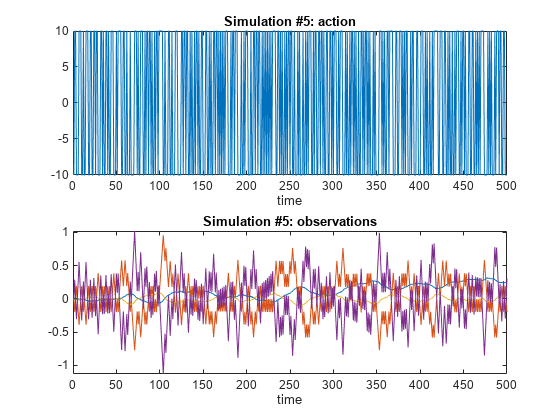cancel
Cancel unfinished reinforcement learning environment simulations on workers
Since R2022a
Syntax
Description
Examples
This example shows how to use Future objects and their methods fetchNext, fetchOutput, cancel, and wait to defer output retrieval for environment simulations running on workers, monitor the status of ongoing simulations, fetch outputs of completed simulations, cancel ongoing simulations, or wait for ongoing simulations to complete.
Load a predefined environment and a suitable agent. For this example use both the environment and agent described in Train AC Agent to Balance Discrete Cart-Pole System.
env = rlPredefinedEnv("CartPole-Discrete"); load("MATLABCartpoleAC.mat","agent")
Start a parallel pool and set up the environment so that it simulates on workers.
pp = parpool(2);
Starting parallel pool (parpool) using the 'Processes' profile ... Connected to parallel pool with 2 workers.
setup(env,UseParallel=true);
To display the simulation completion times, start a timer.
tic
Schedule six simulation to run on the available workers. At the beginning of the simulation, the reset function of the cart-pole environment sets the initial angle of the pole to a random position in the neighborhood of zero (the upward position). This randomization ensures that each simulation is different.
for i=1:6 ftr(i) = runEpisode(env,agent,CleanupPostSim=false); end
Each element of the Future array ftr represents a scheduled simulation.
ftr
ftr=1×6 object
1×6 Future array with properties:
Read
State
Diary
ID
Display the state of each simulation.
ftr.State
ans = 'running'
ans = 'running'
ans = 'queued'
ans = 'queued'
ans = 'queued'
ans = 'queued'
Two simulations are ongoing while the others are queued.
Use fetchNext with a timeout of 0.1 seconds to retrieve results for simulations that complete within that time (if any).
[idx,out] = fetchNext(ftr,0.1)
idx =
[]
out =
[]
Both the outputs are empty, which means that none of the four simulation has completed yet.
Display how many output results have been already retrieved.
ftr.Read
ans = logical
0
ans = logical
0
ans = logical
0
ans = logical
0
ans = logical
0
ans = logical
0
Use fetchNext without any timeout to wait until an unretrieved simulation output becomes available and then return the results.
[idx,out] = fetchNext(ftr)
idx = 2
out = struct with fields:
SimulationInfo: [1×1 struct]
AgentData: [1×1 struct]
Display the state of the simulations.
ftr.State
ans = 'finished'
ans = 'finished'
ans = 'running'
ans = 'running'
ans = 'queued'
ans = 'queued'
As expected, the first two simulations, which were running in parallel on the two workers, are finished, while the next two, which were previously queued, are now running, and the final two are still queued.
Display the time taken for the first two simulations to complete.
toc
Elapsed time is 10.451231 seconds.
Note that once the results from a simulation has been already retrieved, any attempt to use fetchNext to retrieve it again, such as in fetchNext(ftr(2)), will result in an error. To retrieve the results from a Future object that has already been read, you can use fetchOuptuts, such as in fetchOutputs(ftr(2)).
Retrieve the next available result, and display the time elapsed since the simulations started.
[idx,out] = fetchNext(ftr)
idx = 1
out = struct with fields:
SimulationInfo: [1×1 struct]
AgentData: [1×1 struct]
toc
Elapsed time is 11.945070 seconds.
As expected, fetchNext promptly returns the results from the second simulation, since it was already available.
Display how many output results have been already retrieved.
ftr.Read
ans = logical
1
ans = logical
1
ans = logical
0
ans = logical
0
ans = logical
0
ans = logical
0
Cancel the last simulation.
cancel(ftr(6))
Wait for the fourth simulation to complete. The wait function blocks the command prompt until the fourth simulation is completed.
wait(ftr(4))
Display the elapsed time since the simulations started.
toc
Elapsed time is 12.414076 seconds.
Display the state of the simulations.
ftr.State
ans = 'finished'
ans = 'finished'
ans = 'finished'
ans = 'finished'
ans = 'running'
ans = 'finished'
The status of the last element of the array, for which the simulation has been canceled, is classified as 'finished'.
Since any attempt to retrieve results from a simulation that has been canceled will result in an error, remove the canceled object from the array.
ftr(6)=[]
ftr=1×5 object
1×5 Future array with properties:
Read
State
Diary
ID
Use fetchOutputs to wait until all remaining simulations are completed and then retrieve all outputs.
outs = fetchOutputs(ftr)
outs=5×1 struct array with fields:
SimulationInfo
AgentData
Display the elapsed time.
toc
Elapsed time is 16.265069 seconds.
Plot the action and observations from the fifth simulation.
figure subplot(2,1,1); plot(outs(5).AgentData.Time(2:end), ... cell2mat([outs(5).AgentData.Experiences.Action])) title('Simulation #5: action'); xlabel('time'); subplot(2,1,2) plot(outs(5).AgentData.Time(2:end), ... cell2mat([outs(5).AgentData.Experiences.Observation])) title('Simulation #5: observations') xlabel('time');

Clear the array of Future objects, the environment, and delete the parallel pool (this is the reverse order in which they were created).
clear ftr clear env delete(pp)
Input Arguments
Future simulation outputs, specified as a Future object or as an
array of Future objects. To create an element of
F, set the UseParallel property of a
reinforcement learning environment to true, and then use runEpisode to
simulate an agent or a policy within this environment. Assign the element of
F to the output of runEpisode.
Version History
Introduced in R2022a
See Also
Objects
Future|Future|Simulink.Simulation.Future(Simulink)
Functions
fetchNext|fetchOutputs|wait|runEpisode|setup|cleanup|reset
MATLAB Command
You clicked a link that corresponds to this MATLAB command:
Run the command by entering it in the MATLAB Command Window. Web browsers do not support MATLAB commands.
选择网站
选择网站以获取翻译的可用内容,以及查看当地活动和优惠。根据您的位置,我们建议您选择:。
您也可以从以下列表中选择网站:
如何获得最佳网站性能
选择中国网站(中文或英文)以获得最佳网站性能。其他 MathWorks 国家/地区网站并未针对您所在位置的访问进行优化。
美洲
- América Latina (Español)
- Canada (English)
- United States (English)
欧洲
- Belgium (English)
- Denmark (English)
- Deutschland (Deutsch)
- España (Español)
- Finland (English)
- France (Français)
- Ireland (English)
- Italia (Italiano)
- Luxembourg (English)
- Netherlands (English)
- Norway (English)
- Österreich (Deutsch)
- Portugal (English)
- Sweden (English)
- Switzerland
- United Kingdom (English)